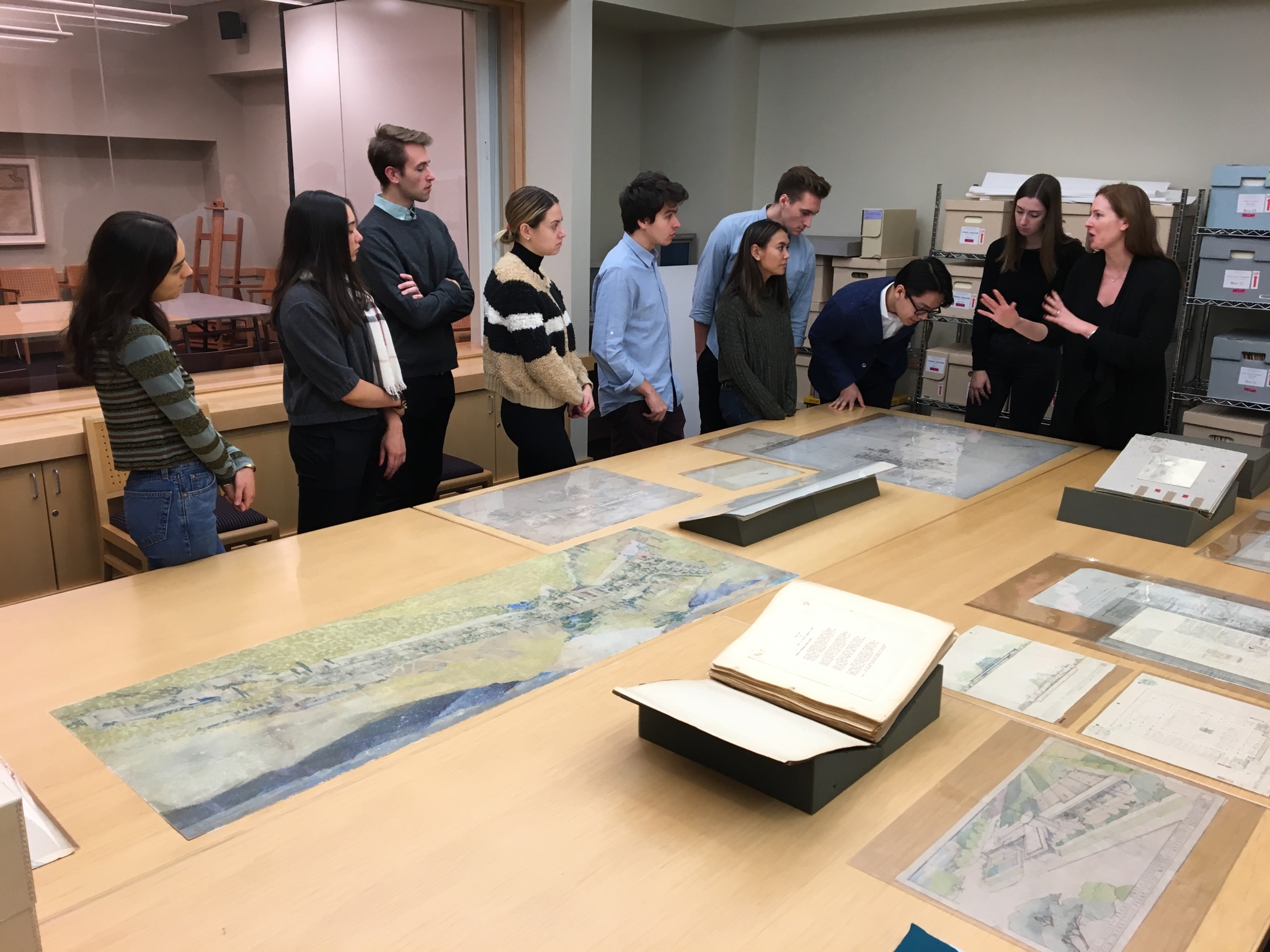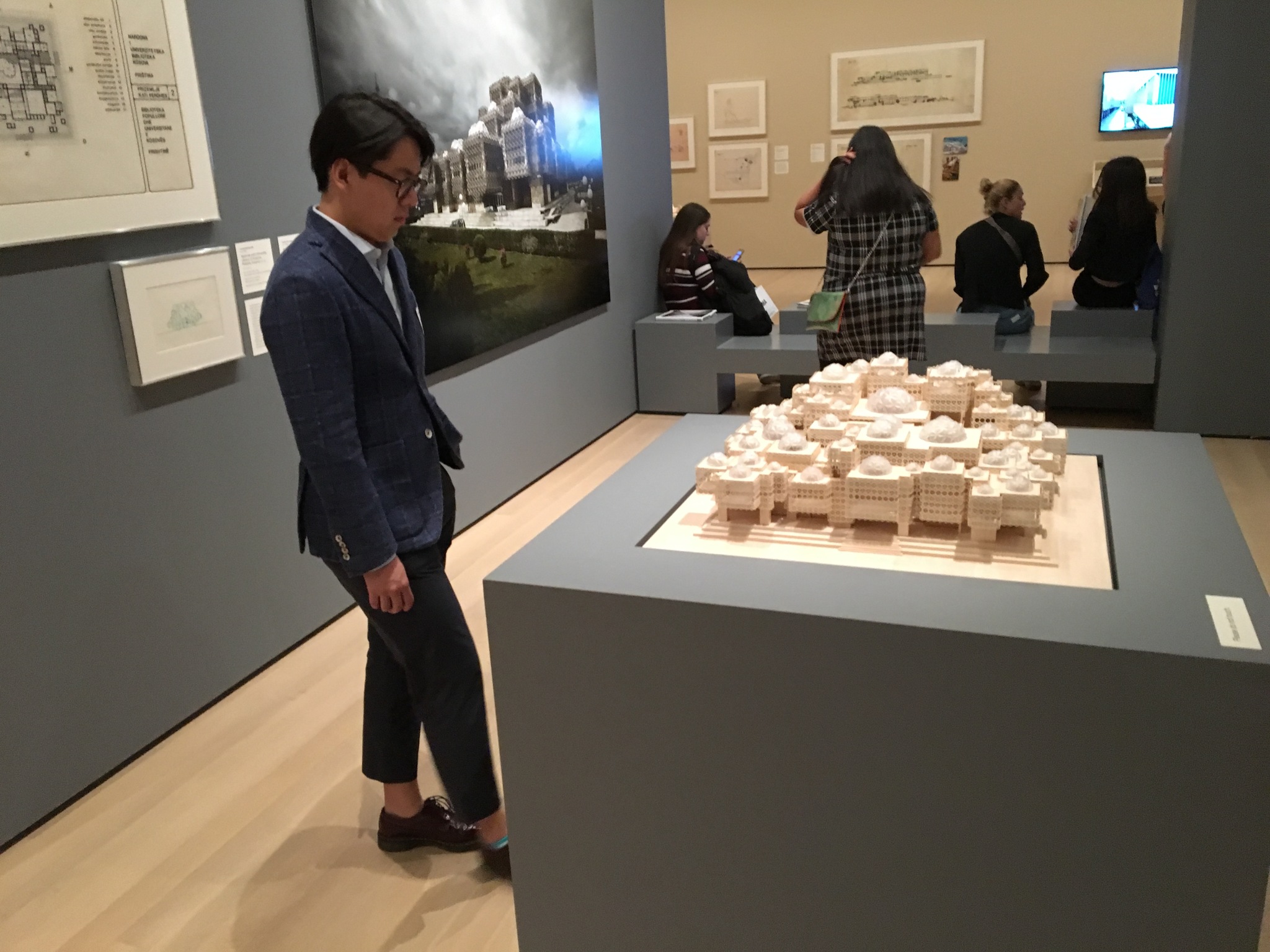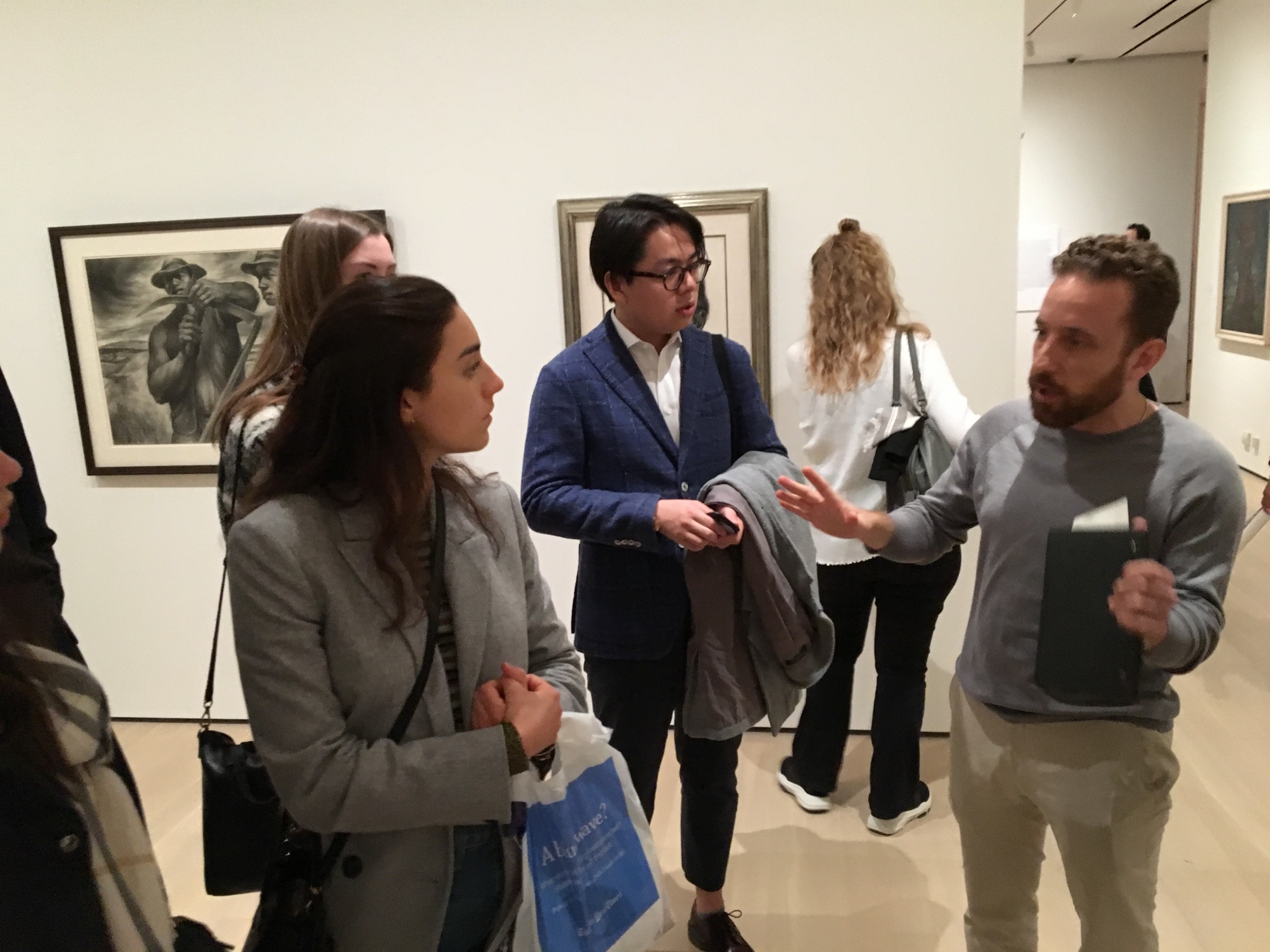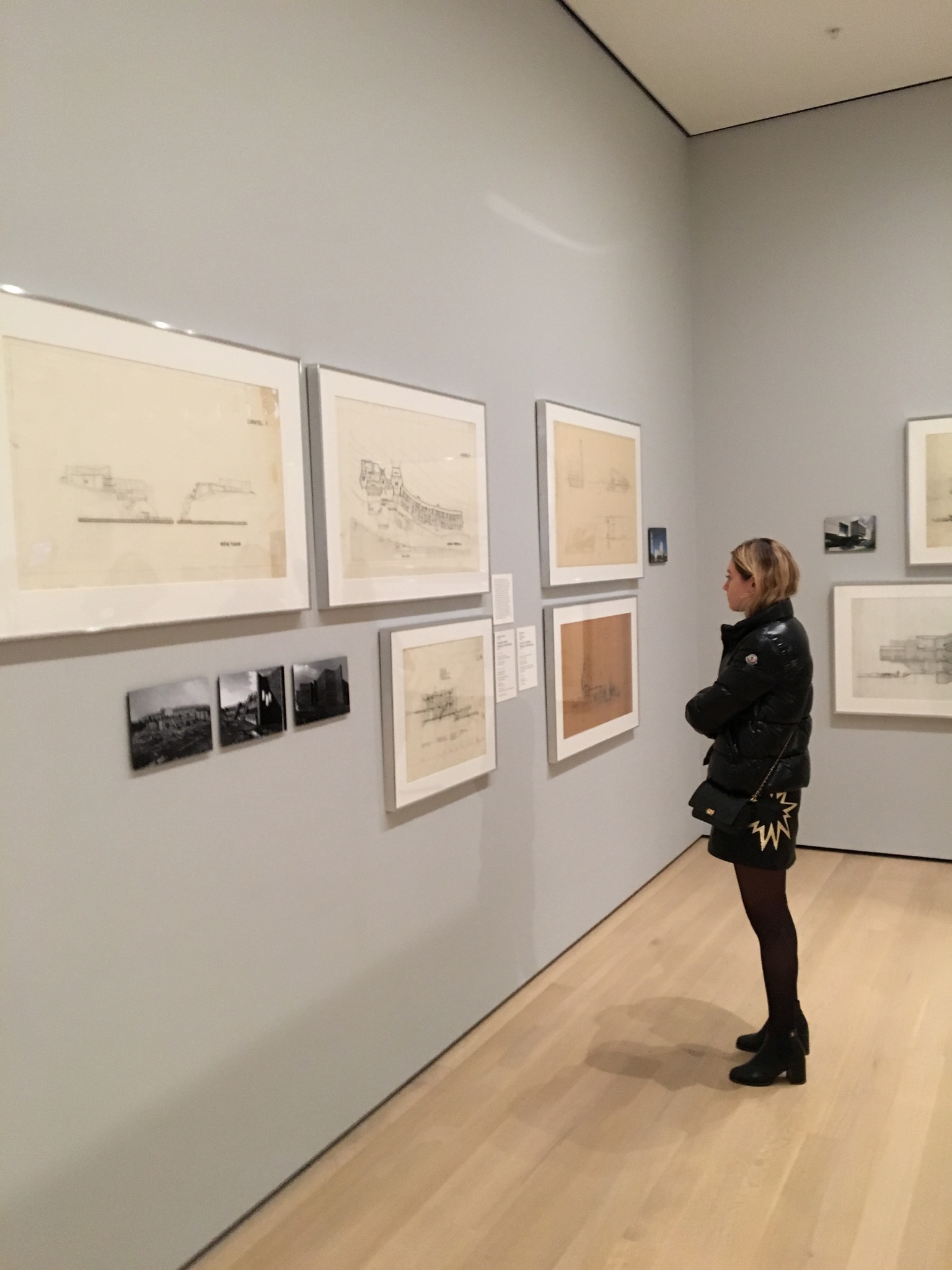Home » Events » Lillian Boyle Reflects on Highlights of Class Field Trip to New York City
Lillian Boyle Reflects on Highlights of Class Field Trip to New York City
Posted by vrcvanderbilt on Tuesday, November 13, 2018 in Events, HART, News, Student/Alumni, Vanderbilt University, VRC.
 In an action-packed three days (October 25-27), my curation seminar class (Exhibiting Historical Art: Architecture at MoMA) traversed New York City from Columbia University on the Upper West Side to the Museum of Modern Art in Midtown and all the way downtown to Greenwich Village to attend a symposium at the Remarque Institute, New York University. The symposium featured experts speaking on Yugoslav history and architecture, including two Vanderbilt University professors, Matthew Worsnick, assistant professor of the practice of art history, and Emily Greble, associate professor of history. The panel also included Svetlana Broz, political activist and granddaughter of the Yugoslav leader Josip Broz Tito.
In an action-packed three days (October 25-27), my curation seminar class (Exhibiting Historical Art: Architecture at MoMA) traversed New York City from Columbia University on the Upper West Side to the Museum of Modern Art in Midtown and all the way downtown to Greenwich Village to attend a symposium at the Remarque Institute, New York University. The symposium featured experts speaking on Yugoslav history and architecture, including two Vanderbilt University professors, Matthew Worsnick, assistant professor of the practice of art history, and Emily Greble, associate professor of history. The panel also included Svetlana Broz, political activist and granddaughter of the Yugoslav leader Josip Broz Tito.
 Highlights of our trip included visits to the archives of the Avery Architectural and Fine Arts Library at Columbia University as well as to MoMA’s groundbreaking exhibit, “Toward a Concrete Utopia: Architecture in Yugoslavia, 1948-1980.”
Highlights of our trip included visits to the archives of the Avery Architectural and Fine Arts Library at Columbia University as well as to MoMA’s groundbreaking exhibit, “Toward a Concrete Utopia: Architecture in Yugoslavia, 1948-1980.”
Jennifer Gray, chief curator of drawings and archives at Avery, led the class through selections from the library’s extensive archives of the legendary American architect Frank Lloyd Wright. Gray discussed the curatorial choices she made that shaped MoMA’s exhibit “Frank Lloyd Wright at 150: Unpacking the Archive,” which she co-curated with historian Barry Bergdoll. This major retrospective, a celebration of the 150th anniversary of the architect’s birth, examined his drawings and models from a variety of critical perspectives. In keeping with the exhibition’s title, Gray “unpacked” the Avery archives for the class and brought the Frank Lloyd Wright exhibit to life again for those who did not see the exhibit during its run in 2017.
 After spending the greater part of the semester studying Yugoslav history, architecture and the exhibition itself, we were all eager to experience “Toward a Concrete Utopia” firsthand—initially with Professor Worsnick, who had worked on the exhibit and contributed essays to the companion volume. The exhibit introduces the viewer to Yugoslavia’s modernist tradition, showcasing the often-daring forms and innovative designs of its architects from 1948 to 1980, including Bogdan Bogdanović, Juraj Neidhardt, Svetlana Kana Radević, Edvard Ravnikar, Vjenceslav Richter, and Milica Šterić, among others. It focuses on the period of intense construction in the former Yugoslavia from its break with the Soviet bloc in 1948 to the death of the country’s longtime leader Josip Broz Tito in 1980. The works on display—around 400 drawings, models, photographs, and film reels—are drawn from an array of more than 50 municipal archives, private collections, and museum holdings in the region and across Europe and the United States.
After spending the greater part of the semester studying Yugoslav history, architecture and the exhibition itself, we were all eager to experience “Toward a Concrete Utopia” firsthand—initially with Professor Worsnick, who had worked on the exhibit and contributed essays to the companion volume. The exhibit introduces the viewer to Yugoslavia’s modernist tradition, showcasing the often-daring forms and innovative designs of its architects from 1948 to 1980, including Bogdan Bogdanović, Juraj Neidhardt, Svetlana Kana Radević, Edvard Ravnikar, Vjenceslav Richter, and Milica Šterić, among others. It focuses on the period of intense construction in the former Yugoslavia from its break with the Soviet bloc in 1948 to the death of the country’s longtime leader Josip Broz Tito in 1980. The works on display—around 400 drawings, models, photographs, and film reels—are drawn from an array of more than 50 municipal archives, private collections, and museum holdings in the region and across Europe and the United States.
On a second visit to MoMA, Mack Cole-Edelsack, architect and senior design manager in the department of exhibition design, offered the class another perspective on the exhibit, namely its exceptional design. Organized thematically, the galleries are divided into four broad categories or sections: modernization, global networks, everyday life, and identities. Original drawings and models are interspersed with Swiss photographer Valentin Jeck’s contemporary photographs of some of the most iconic buildings and monuments of the historically multiethnic region. Video installations by the filmmaker Mila Turajlić, drawn from documentary footage, newsreels, feature films, and TV shows, introduce some of  the themes that structure the show, such as large-scale urbanization, design for everyday life, the global reach of Yugoslav architecture, and the reconstruction of the city of Skopje after the devastating 1963 earthquake, among others.
the themes that structure the show, such as large-scale urbanization, design for everyday life, the global reach of Yugoslav architecture, and the reconstruction of the city of Skopje after the devastating 1963 earthquake, among others.
Our time at the Museum of Modern Art that day ended on a high note with a roundtable discussion with Vladimir Kulić, co-curator of the “Toward a Concrete Utopia” exhibit, Svetlana Broz, and the MoMA Mellon MRC Fellows. I had the opportunity to ask Svetlana Broz about her experience as a woman and the feminist movement in Yugoslavia. Her insightful response enhanced my understanding of the female experience in her country, greatly contributing to my final paper on female architects in socialist Yugoslavia.
We spent our morning on Museum Row at New York University’s Institute of Fine Arts where the class discussed curatorial strategy with Jean-Louis Cohen, esteemed architectural scholar and curator of many exhibitions, including “Le Corbusier: An  Atlas of Modern Landscapes” at the Museum of Modern Art in 2013. Our discussion provided the perfect ending for our ongoing conversations throughout the weekend about curatorial decision making, theory, and practice. In addition, Professor Worsnick led an architectural tour of the James B. Duke mansion, a historic landmark that is now home to the Institute. Afterwards, in the time remaining, we split up to visit the museum of our choice before heading to the airport.
Atlas of Modern Landscapes” at the Museum of Modern Art in 2013. Our discussion provided the perfect ending for our ongoing conversations throughout the weekend about curatorial decision making, theory, and practice. In addition, Professor Worsnick led an architectural tour of the James B. Duke mansion, a historic landmark that is now home to the Institute. Afterwards, in the time remaining, we split up to visit the museum of our choice before heading to the airport.
This wonderful weekend profoundly inspired my fellow students and me to continue our study of the history of art, pursue graduate degrees, and explore careers in curation. Thank you to Professors Matthew Worsnick, Betsey Robinson, and Kevin Murphy, and Julia Kamasz and the History of Art department for making the class trip possible!—Lillian Boyle
*Photographs courtesy of Matthew Worsnick

©2024 Vanderbilt University ·
Site Development: University Web Communications